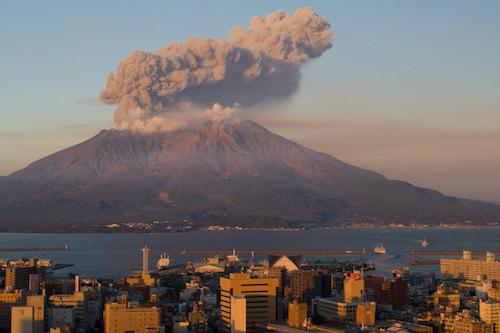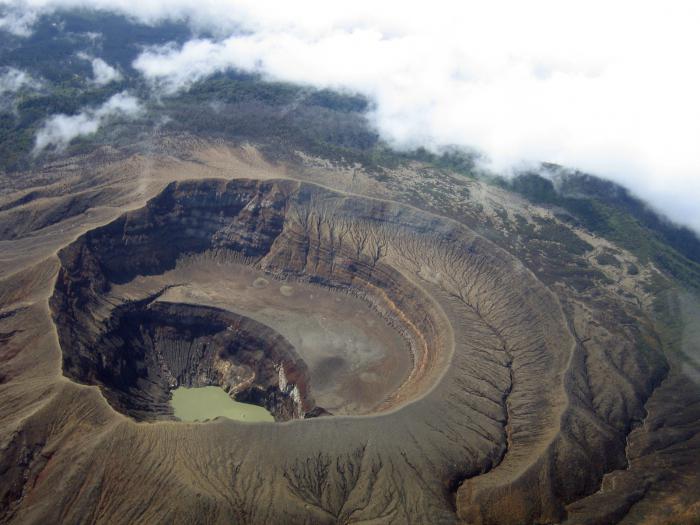Today we will consider such an interesting topic as volcanoes. The structure of volcanoes and their classification are described in detail in this article.
Volcanoes got their name by the name of Volcano, the god of fire. They represent geological formations that arise over cracks and channels in the earth's crust. The large volcanoes that erupt before your eyes are an incomparable sight. Lava, rock fragments and hot gases from magmatic sources are thrown to the earth's surface through cracks and channels. Volcanoes are usually individual mountains composed of eruption products. They can reach the height of large sizes. For example, the largest volcanoes in Africa are Kilimanjaro (5895 meters), Cameroon (4100 meters) and Teide (3718 meters).
Extinct, asleep and active volcanoes
The current ones are those that are currently erupting periodically or continuously. For example, the active volcanoes of Africa are Nyiragongo, Meru, Karisimbi, Fako, Teide. Asleep - these are volcanoes whose eruptions are not known, but they retained their shape and local earthquakes occur beneath them. Extinct volcanoes are called extinct and severely destroyed, not showing activity. A photo of the active Arenal volcano located in Costa Rica is presented below.
Division of volcanoes into fractured and central
Volcanoes are divided according to the shape of the supply channels into fissure and central. Considering the structure of the volcano (the diagram is presented below), it should be noted that magma chambers can be located in the upper mantle at a depth of about 50-70 kilometers (for example, the Kamchatka volcano Klyuchevskaya Sopka). They can also be in the earth's crust, at a depth of about 5-6 meters (Italian volcano Vesuvius) or deeper.
Long and short eruptions
Volcanic eruptions can be long (from several years to several centuries) and short-term, which are measured in hours. Acoustic phenomena, volcanic earthquakes, changes in the composition and magnetic properties of fumarole gases, as well as some other phenomena that are noted before volcanoes erupt can be attributed to their precursors. A photo of the erupting volcano is presented below.
How does the eruption begin?
Usually it begins with the fact that there is an increase in gas emissions. They are thrown out first with cold, dark debris of lava, and then with red-hot ones. In some cases, these emissions are accompanied by an outpouring of lava. From 1 to 5 km, depending on the strength of the explosions, the height of the rise is saturated with debris of lava and the heat of water vapor and gas. And the largest volcanoes can throw eruption products to even greater heights. For example, in 1956, in Kamchatka, during the eruption of Bezymyannyi volcano, it was 45 kilometers. At distances from several thousand to tens of thousands of kilometers, discarded material is carried. Its volume sometimes reaches several cubic kilometers. The concentration in the atmosphere of volcanic ash during some eruptions is so great that there is a darkness comparable to the darkness indoors. It was observed, in particular, in the village of Klyuchi, located 40 km from Bezymyannyi volcano, in 1956.
The layout of the volcano, presented below, will help you understand its structure.
What is an eruption?
An eruption is an alternation of strong and weak explosions, as well as an outpouring of lavas. The maximum explosions are called the culmination of paroxysms. A decrease in the strength of explosions and then a gradual cessation of eruptions is observed after them. Dozens of km³ of spilled lava emit the largest volcanoes. The photo below shows the structure of the volcano. This scheme gives a visual representation of how it erupts.
Types of Eruptions
Volcanic eruptions are not always the same. There are 4 types of them, depending on the viscosity of the lavas and the amount of products (solid, gaseous and liquid): explosive (volcanic), extrusive (domed), mixed (strombolian) and effusive (Hawaiian).
The Hawaiian type, most often creating thyroid volcanoes, is characterized by a rather calm outpouring of basalt (liquid) lava, which forms lava flows and fire-liquid lakes in the craters. Small amounts of gas form fountains that drop droplets and lumps of liquid lava, drawn into thin glass filaments during the flight.
In the Strombolian type, which is usually created by strato-volcanoes, along with rather abundant outpourings of lava of andesitobasaltic and basaltic composition, small explosions predominate, during which pieces of slag are thrown, as well as various spindle-shaped and twisted bombs.
In the dome type, it is gaseous substances that play a large role. They produce explosions, as well as emissions of large black clouds crowded with many fragments of lava. Small flows form viscous lavas of andesitic composition.
Eruption Products
Solid, gaseous and liquid are the products of the eruption of various volcanoes. Volcanic gases that are released both during the eruption (called eruptive) and during the quiet activity of the volcano (furamol) from cracks located on the slopes of the volcano, as well as from its crater, pyroclastic rocks and lava flows, form hot springs, passing through groundwater.
Lava - red-hot, very viscous or liquid, mostly silicate, mass that pours onto the surface of the Earth during volcanic eruptions (see sectional view of the volcano in the photo below). When it hardens, effusive rocks are formed.
Volcanics (volcanic rocks) - rocks that are formed as a result of volcanic eruptions. Distinguish, depending on the nature of the eruption, effusive or erupted (diabases, liparites, trachytes, andesites, basalts, etc.), pyroclastic, or volcanic-detrital (volcanic breccias, tuffs) volcanic rocks.
Volcanic apparatus
A tectonic fault (tectonic break) is a violation of the integrity of rocks (thrusts, thrusts, faults, faults, etc.) due to movements of the earth's crust.
The photo below shows the layout of the volcano.
Depending on the composition of magma and the nature of eruptions, structures of various heights and shapes appear on the surface. Each time the structure of the volcano is unique. The picture above is just an example. Volcanic apparatuses consist of a cracked or tube-shaped channel, a vent (upper part of the channel), volcanic-clastic products and accumulations of lavas surrounding the channel on different sides, and a crater (a funnel-shaped or bowl-shaped depression on the slope or top of the volcano, whose diameter is from several meters to several kilometers ) The most common forms are cone-shaped, with a predominance of emissions of various clastic material, and dome-shaped (when a viscous lava is squeezed out).

Eruptions occur not only through the tops of the main crater, but also through side (otherwise called parasitic) craters that have volcanoes. The structure of volcanoes is characterized by the fact that secondary craters are located on the slopes, as well as at some distance from the peaks of the main one. Often with single eruptions of gases that pierce the channel to the earth's surface, funnel-shaped depressions form. They are bordered by an annular shaft, consisting of blocks of different rocks. Often such funnels are filled with water. They are called Maars. Sometimes strong eruptions are accompanied by the fact that parts of volcanic structures collapse. Often this applies to the terrain, near which there are volcanoes. The structure of volcanoes sometimes leads to its collapse. The hollows that are formed in this case, in diameter, reach from several to several tens of kilometers. They are called calderas.
Underwater volcanoes
We dismantled the structure of volcanoes. It should be noted that one of their varieties is underwater, located at the bottom of the reservoir. Today, the geographical coordinates of volcanoes of this type are concentrated mainly within the three volcanic zones: the Atlantic, Mediterranean-Indonesian and Pacific. According to the results of a study of the past of our planet from the point of view of geology, in their scale, as well as in the volume of emission products coming from the bowels of the Earth, they significantly exceed those on land. If annually on land from 20-30 eruptions on average up to 1.5 km³ of molten magma enters annually, then from submarine volcanoes during the same time 12-15 times more material is erupted. The activity of submarine volcanoes supports life in the waters of the ocean near its surface. And on it, in turn, depends on the volume of greenhouse gases absorbed by the ocean.
Eruptions of submarine volcanoes
If the reservoir is located above the volcanic source, the pyroclastic material during the eruption is saturated with water and then spreads around the source. Such deposits were first described in the Philippines. They were formed during the eruption of the Taal volcano in 1968, which is located at the bottom of the lake. Deposits of this type are often represented by thin wavy layers of pumice. Islands can form as a result of volcanic eruptions. This, for example, is located in the Indian Ocean volcanic island of Reunion.
Causes of volcanic activity
The close relationship between the moving parts of the earth's crust and the belts of volcanic activity is indicated by the geographical location of volcanoes. Faults formed in such zones are channels through which magma moves to the earth's surface. This occurs, apparently, under the influence of various tectonic processes. When the pressure of the gases dissolved in the magma becomes deeper than the pressure of the overlying ones, they begin to move to the surface of the earth, dragging magma along with them. It is possible that during crystallization of magma gas pressure is created when its liquid part is enriched with steam and residual gases. Magma seems to boil. High pressure is created in the outbreak as a result of the release of a large volume of gaseous substances. It can also be one of the causes of the eruption.

The formation and structure of the volcano are very interesting topics. In this article, we have only briefly reviewed them. The internal structure of the volcano is still of interest to many researchers. They are still engaged in its study.
For the first time in school years, we get acquainted with what a volcano is. Geography gives us the opportunity to come closer to understanding how our planet works. The Earth is fraught with many mysteries, which will be solved by the next generation. Of course, the school tells us only the main points when studying the structure of the volcano. Grade 5 is not the age when you should delve into this topic. However, sometimes this can and should be done. We hope you learned something new for yourself from this article.